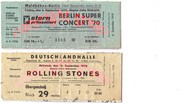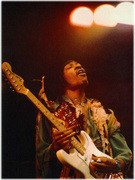The Jimmy Hendrix Story
The Jimmy Hendrix Story - Lost and found Ticket Sale
Johnny Allen Hendrix (later re-named James Marshall Hendrix) was born on November 27, 1942, in Seattle, Washington, USA. Hendrix's parents divorced when he was nine years old, and in 1958 his mother died. He went to live with his Cherokee grandmother because of his unstable household. At age 12, he received his first guitar, an acoustic to replace the broom stick he would strum like one.[4] Learning quickly, he played in many local bands, playing as far away as Vancouver.[4] Hendrix did not graduate from high school. Hendrix later claimed that he was expelled for holding hands with his white girlfriend, but when questioned later, his principal insisted that it was due to poor grades and frequent absences.
Hendrix got into trouble with the law twice for riding in a stolen car. He was given a choice between spending two years in prison or joining the army. Hendrix chose the latter and enlisted on May 31, 1961. After completing boot camp he was assigned to the 101st Airborne Division and stationed in Fort Campbell, Kentucky. His commanding officers considered him to be a sub-par soldier: he slept while on duty, had little regard for regulations and showed no skill as a marksman.[5] He was given an early release from military service in Fort Campbell, Kentucky for "behavioral problems".[6]
http://en.wikipedia.org/wiki/Jimi_Hendrix
The Jimi Hendrix Experience
Early in 1966 at the Cheetah Club on West 21st Street, Linda Keith, the girlfriend of Rolling Stones guitarist Keith Richards, befriended Hendrix and recommended him to Stones manager Andrew Loog Oldham and producer Seymour Stein. Neither man took a liking to Hendrix's music, however, and they both passed. She then referred him to Chas Chandler, who was ending his tenure as bassist in The Animals and looking for talent to manage and produce. Chandler was enamored with the song "Hey Joe" and was convinced that he could create a hit single by remaking it into a rock song.
Impressed with Hendrix's version, Chandler brought him to London and signed him to a management and production contract with himself and ex-Animals manager Michael Jeffery. Chandler then helped Hendrix form a new band, The Jimi Hendrix Experience, with guitarist-turned-bassist Noel Redding and drummer Mitch Mitchell, both British musicians. Shortly before the Experience was formed, Chandler introduced Hendrix to Pete Townshend and to Eric Clapton, who had only recently formed Cream. At Chandler's request, Cream let Hendrix join them on stage for a gig. Hendrix and Clapton remained friends up until Hendrix's death.
Original Neverused Jimmy Hendrix 1970 Concertticket!
One and Only Ticket in the world?
Found in1970 diary from german fan now selling Real tickets berlin concerts...1970....
one & only in the world, ?! probably a yes for both......
The tickets belong to the owner of the diary shown above...His name is Greco K.:) .. .reading the days before and after brings you in the times of the 60 sixtees ,.... .the sixtees ended for jimmy two weeks after the berlinconcert in 1970 ...The berlin concert was one of the few concerts he gave before he died....Greco K...who is a old fan desided to sell the tickets to the real fan taking care of it.... Selling the tickets is like selling his soul to it . The cards are priceless, so we ll glued a price to so greco emotionally can get along a agreement actually seling the cards. Priceless to him...Maybe someone has a acceptable price to it. Found in1970 diary from german fan now selling 1970 papertickets Jimmy Hendrix + original diary to it , the cards belong to geco .... He went to both the concerts and writes about it in his diary wich makes the cards extra special. The jimmy hendrix concert was moved to the deutschlandhalle.
http://jimmyhendrix.50megs.com
Personality
Fashion
Hendrix was well known for his unique sense of fashion, and strived to perfect his hairstyle and wardrobe almost to the point of obsession. A set of hair curlers was one of the few possessions that travelled with him to England upon his discovery in 1966. When his first advance check arrived, Hendrix immediately took to the streets of London in search of clothing at obscure fashion haunts like I Was Lord Kitchener's Valet, where he purchased an ages old British military jacket adorned with tasseled ropes. A traffic warden once ordered him to remove the jacket, citing it as an offense to the Queen.
Many photographs of Hendrix show him wearing various rings, medallions, and brooches, and Hendrix often peppered his attire with pins that professed his support for the hippie movement or his fascination with folk singer Bob Dylan. His only vacation, a two week trip to Morocco with friends Colette Mimram and Deering Howe, deeply affected his sense of art and style, and upon his return Hendrix filled his Greenwich Village apartment with Moroccan art and decor. Mimram and Stella Douglas, the wife of producer Alan Douglas, created some of Hendrix's most memorable attire: a Bowler style derby adorned with either an angled feather or a set of silver bangles, a Trilby hat crowned with a purple scarf and adorned with various brooches, the blue dashikis he wore on the Dick Cavett Show, and the blue on white fringed jacket that he wore at Woodstock.
He had enough of a sense of humor to poke fun at himself, specifically with the song "Purple Haze." A mondegreen had appeared, in which the line "'Scuse me while I kiss the sky" was misheard as "Scuse me while I kiss this guy." It is claimed that, in a few performances, Hendrix deliberately enunciated the line so as to emphasize the mondegreen.[citation needed] A volume of misheard lyrics has been published, with this mondegreen itself as the title, and Hendrix illustrated on the cover, taking the phrase literally.
Politics and racism
Even after achieving worldwide success as a musician, Hendrix could not avoid experiences of racism, which was omnipresent whenever he returned to the Southern United States.
Jimi was also shunned by much of the black community for playing "white music" and for having white musicians in his band. Weeks after Woodstock, his performance at a Harlem block party became a harrowing experience. Within seconds of arriving at the site, his guitar was stolen from the back seat of his car by two Harlem thugs. When he appeared stageside to watch the early acts with his girlfriend Carmen Borrero (a Puerto-Rican model), the crowd verbally harassed the pair. When he appeared on stage, he was bottled, and had eggs thrown at him from the crowd. After the show, drummer Mitch Mitchell and roadie Eric Barrett were physically assaulted while dismantling their set.
Hendrix was also constantly harassed by various civil rights oriented activist and extremist groups who wished to use his fame to further their own message or cause. The Black Panthers even went as far as posting signs for his appearance at a benefit concert that Hendrix never even knew existed.
Drug use
Hendrix is widely known for and associated with the use of hallucinogenic drugs, most notably LSD. A common opinion is that Jimi's use of LSD was integral in unlocking his creative process. He had never taken hallucinogens until the night he met Linda Keith, but likely experimented with other drugs in years prior. Various forms of sleeping pills and speed fueled his "stop and go" lifestyle throughout his career, and pictures exist of Hendrix smoking marijuana.
Jimi was also notorious among friends and bandmates for becoming angry and violent when he drank alcohol. Kathy Etchingham spoke of an incident that took place in a London pub in which an intoxicated Hendrix beat her with a public telephone handset because he thought she was calling another man on the payphone. Alcohol was also cited as the cause of Hendrix's 1968 rampage that destroyed a Stockholm hotel room and led to his arrest. Musician Paul Caruso's friendship with Hendrix ended in 1970 when Jimi punched him during an alcohol-fueled argument.
The most controversial topic however, concerns his alleged use of heroin. The Hendrix family, along with a portion of his friends and biographers, emphatically maintains that Hendrix was never a heroin user, citing his irrational fear of needles. Known today as trypanophobia, this condition was never medically diagnosed in Hendrix. A toxicology report prepared shortly after his death found no heroin in his body, nor were there any marks from needles. [15]
Read the total story on http://en.wikipedia.org/wiki/Jimi_Hendrix
wikpedia >Gravesite
Although Hendrix had verbally requested to be buried in England, his body was returned to Seattle and he was interred in Greenwood Memorial Park, Renton, Washington. Al Hendrix created a five-plot family burial site to include himself, his second wife Akayo June, his adopted daughter Janie, and son Leon. The headstone for Jimi contains a drawing of a Stratocaster guitar, though it is depicted as the instrument of a traditional right-handed player. (Hendrix played the instrument left-handed.)
As the popularity of Hendrix and his music grew over the decades following his death, concerns began to mount over fans damaging the adjoining graves at Greenwood, and the growing extended Hendrix family further prompted Al to create an expanded memorial site separate from other burial sites in the park. The memorial was announced in late 1999, but Al's deteriorating health led to delays. He died two months before its scheduled completion in 2002. Later that year, the remains of Jimi Hendrix, his father Al Hendrix, and grandmother Nora Rose Moore Hendrix were moved to the new site.

The memorial is an impressive granite dome supported by three pillars under which Jimi Hendrix is interred. Jimi's autograph is inscribed at the base of each pillar, while two stepped entrances and one ramped entrance provide access to the dome's center where the original Stratocaster adorned headstone has been incorporated into a statue pedestal. A granite sundial complete with brass gnomon adjoins the dome, along with over 50 family plots that surround the central structure, half of which are currently adorned with raised granite headstones.
To date, the memorial remains incomplete: brass accents for the dome and a large brass statue of Hendrix were announced as being under construction in Italy, but since 2002, no information as to the status of the project has been revealed to the public. In addition, a memorial statue of Jimi playing a Stratocaster stands near the corner of Broadway and Pine Street in Seattle.
In May 2006 Seattle honored the music, artistry and legacy of Jimi Hendrix with the naming of a new park near Seattle's historic Colman School in the heart of the Central District.


